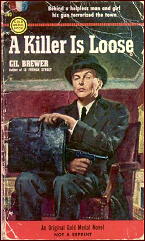Sat 11 Jul 2009
A 1001 MIDNIGHTS review: GIL BREWER – A Killer Is Loose.
Posted by Steve under 1001 Midnights , ReviewsNo Comments
by Bill Pronzini:
GIL BREWER – A Killer Is Loose. Gold Medal 380, paperback original; 1st printing, March 1954.

In the 1950s and 1960s, Gil Brewer occupied a major stall in the stable of writers of Gold Medal paperback originals, along with John D. MacDonald, Richard S. Prather, and Charles Williams.
Brewer’s work was uneven but usually interesting and evocative, and quite popular from 1951 to 1958; his first novel, 13 French Street (1951), sold more than a million copies. Much of his fiction is built around the theme of a man corrupted by an evil, designing woman; but his two best novels, this one and The Red Scarf, are departures from that theme.
Set in Florida, as is most of Brewer’s fiction, A Killer Is Loose is a truly harrowing portrait of a psychotic personality that comes close to rivaling the nightmare portraits in the novels of Jim Thompson.
It tells the story of Ralph Angers, a deranged surgeon and Korean War veteran obsessed with building a hospital, and his devastating effect on the lives of several citizens. One of those citizens is the narrator, Steve Logan, a down-on-his-luck ex-cop whose wife is about to have a baby and who makes the mistake of saving Angers’s life, thus becoming his “pal.”
As Logan says on page one, by way of prologue, “There was nothing simple about Angers, except maybe the Godlike way he had of doing things.”
Brewer maintains a pervading sense of terror and an acute level of tension throughout. The novel is flawed by a slow beginning and a couple of improbable occurrences, as well as by an ending that is a little abrupt — all of which are the probable result of hasty writing. (Brewer once said that he wrote most of his early novels in a white heat of seven to ten days.)
But its strengths far outnumber its weaknesses. Two aspects in particular stand out: One is the curious and frightening relationship that develops between Logan and Angers; the other is a five-page scene in which Angers, with Logan looking on helplessly, forces a scared little girl to play the piano for him — a scene Woolrich might have written and Hitchcock should have filmed.
———
Reprinted with permission from 1001 Midnights, edited by Bill Pronzini & Marcia Muller and published by The Battered Silicon Dispatch Box, 2007. Copyright © 1986, 2007 by the Pronzini-Muller Family Trust.